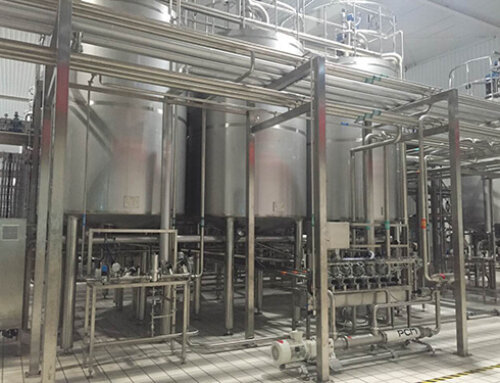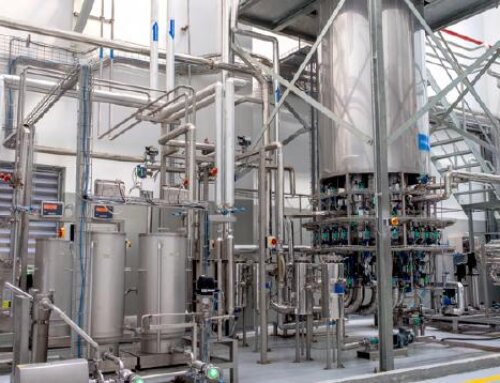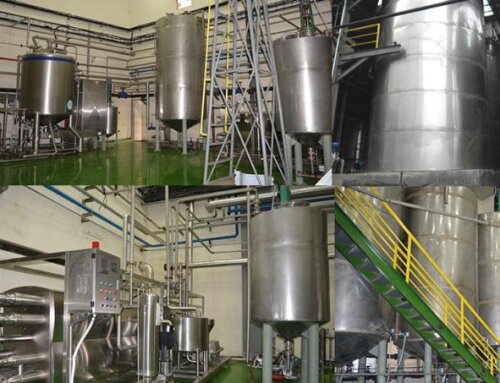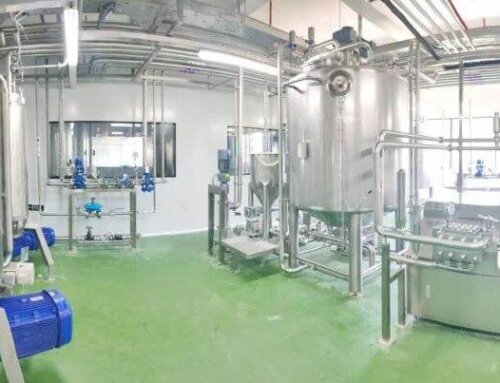Flavored Milk Processing Introduction
Flavored milk is a ready-to-drink product produced from raw fresh milk, mixed with sugar and natural flavors (e.g. banana, pineapple, orange, chocolate etc), then homogenized, pasteurized/UHT sterilized and degassed, filled into the containers for direct consumption.
The flavored milk can be made as a pasteurized refrigerated product; or as an ultra-high temperature (UHT) processed product that does not require refrigeration according to different sterilizing processes and packaging containers.
The raw ingredients for flavored milk processing can be fresh milk or milk powder and other powder ingredients.
The flavored milk production process typically involves several stages, including raw milk reception, milk standardization, the addition of flavors, sweeteners, and colors in the milk, pasteurization, homogenization, cooling, filling into containers, and packaging.
Industrial flavored milk processing machines include raw milk receiving system, raw milk standardization tank, flavored milk blending system, high-pressure milk homogenizer, milk degasser, milk pasteurizer/UHT sterilizer, flavored milk carton/bottle filling and packing machines, hot water generating system, RO water generating system, CIP cleaning system.
The flavored milk processing machines are made of food-grade SUS304/SUS316L material to ensure producing high-quality products.
The whole processing line has the characteristic of highly flexibility, high automatic degree, save labor and energy. The product flavor, end package and production process can be customized according to clients’ requirements and budgets.
The capacity of the flavored milk production is from 500L/H to 10000L/H, and the end products can be filled into bottles, metal cans, tetra pak cartons or pouches.

Flavored Milk Ingredients
When we produce flavored milk, the raw milk, flavors and sweeteners, stabilizers, vitamins and minerals are the main ingredients.
—Fresh Milk/Milk Powder: Milk is the primary ingredient in flavored milk and provides the base for the beverage, it contains protein, calcium, and vitamins, which are important for maintaining good health. To ensure the quality and consistency of the final product, the milk used in flavored milk processing is typically standardized to a specific fat content.
—Flavors and sweeteners: Flavors and sweeteners are added to milk to create a unique taste and aroma. Flavors mainly include all kinds of fruit juice, vanilla, chocolate, strawberry, and many others; Sweeteners, such as sugar, sugar substitute, corn syrup, are added to enhance the flavor and make the milk more appealing to consumers. The selection of flavors and sweeteners depends on consumer preferences and market trends.
—Stabilizers and emulsifiers: Stabilizers and emulsifiers are added to flavored milk to improve its texture and prevent separation. Stabilizers help to thicken the milk and prevent the flavors and sweeteners from settling at the bottom of the container. Common stabilizers include carrageenan, xanthan gum, and pectin. Emulsifiers help to mix the milk and flavorings evenly, so that the final product has a consistent texture. Some commonly used emulsifiers include lecithin and mono- and diglycerides.
—Vitamins and minerals: Some manufacturers may also fortify flavored milk with vitamins and minerals to make it more nutritious. For example, vitamin D and calcium may be added to enhance bone health, while vitamin A and iron may be added to support eye health and prevent anemia.
—Preservatives: In some cases, preservatives may be added to flavored milk to extend its shelf life and prevent spoilage. Common preservatives used in flavored milk processing include potassium sorbate and sodium benzoate.
Flavored Milk Production Process
The production process for flavored milk is similar to that of pasteurized milk/UHT production process, but with a few additional steps. The following is a step-by-step guide to the flavored milk production process:
- Raw milk reception: Raw milk is received from the farm and undergoes testing to ensure it meets the quality standards for milk production. The milk is received and weighed by tanks then cooled and stored in milk silos where it is kept at a cool temperature(5℃) to prevent spoilage.
- Milk standardization: The milk is standardized to ensure consistent quality and fat content. The fat content of the milk is adjusted to the desired level by adding cream or separating the fat with the centrifuge milk separator.
- Milk flavoring and mixing: The ingredients such as flavors, sugar and emulsifiers are added to the milk in a mixing tank according to the recipe, and then start stirring to mix all ingredients evenly.
- Flavored milk homogenization: The flavored milk is heated to 55℃for homogenization, the process can break down the fat globules and to ensure that the flavoring and sweetening agents are evenly distributed throughout the milk to obtain a smooth and consistent texture of the end products.
- Flavored milk degassing: after the milk is homogenized, then flow to a vacuum degasser, the degassing helps to improve the shelf life of flavored milk by reducing the amount of air trapped in the product. This can help to prevent spoilage and improve the overall quality of the product.
- Flavored milk pasteurization/sterilization: The flavored milk is pasteurized or UHT sterilized to eliminate harmful bacteria and extend the shelf life according to clients’ process flowchart, end package and shelf life of the end products.
- Flavored milk filling and packaging: After the milk is sterilized, then cooled down to the filling temperature, and the milk can be aseptically filled into cartons or hot-filled into bottles for distribution.

Flavored Milk Processing Machine Introduction
Raw milk receiving and standardizer machine
The Raw milk receiving and standardizer machine involves raw milk receiving tanks and weighing tanks, milk plate cooler and milk silo storage tanks, milk standardization tanks. All these tanks are made of SUS304 material, and the tank volume can be customized according to processing capacity.

Milk flavoring and mixing tank
The sugar, milk powder, or powder flavorings can be dissolved in a high-shear mixing tank or water powder mixer with hot water. The high shear mixer has high rotation speed from 1400rpm-2900rpm available to dissolve all the solid material into the liquid products. Then the liquid flavor material will be pumped into the blending tank to mix with raw milk to make the flavored milk.

Flavored milk homogenizer, degasser and sterilizer
The vacuum degasser adopts vacuum system to remove the smelly and oxygen in the flavored milk, it include one vacuum degassing tank, vacuum pump and condenser. Working temperature is 55℃. Full-automatic control, SUS304 stainless steel, differential pressure transducer imported from Germany Labom, working vacuum degree -0.64~-0.85Kpa, working together with sterilizer.
The high pressure homogenizer is made of SUS304, maximum pressure 25MPa, working pressure 18-20MPa, including stainless steel starter cabinet, the electrical components in the cabinet are mainly Schneider brand, frequency conversion speed regulation, handle pressure and pressure reduction.
Flavored milk is pasteurized by plate pasteurizer or UHT sterilizer. The pasteurizing process is 75-85℃ holding for 15S, cooling to 4℃ for cold filing. The UHT sterilizing process is 135℃ holding for 3-5S, cooling to 25℃ for aseptic filing. The material contacting parts are made of SUS304 stainless steel,with material balance tank , plate/tubular heater exchanger, sanitary centrifugal pump, product pump, hot water tank, electic cabinet, Stainless steel square pipe frame, self CIP cleaning system, UK Spirax Sarco steam control system; German Jumo temperature sensor; Schneider electronic parts.

Flavored milk filler
The flavored milk after sterilizing/pasteurizing can be filled into cartons, metal cans or plastic/glass bottles. When hot filling into the PP/PE bottles, one aluminum foil sealing machine will be used between the filling and capping machine. The filling temperature is usually kept at 30-40℃.
Flavored milk secondary sterilizer
When using the milk powder as raw products to produce the flavored milk, the flavored milk is filled into cans, PE bottles or glass bottles, then after filling, the flavored milk will be fed into the retort sterilizer for secondary sterilizing to get a stable shelf life, the sterilizing process will be 121℃ for 15-20 minutes.





